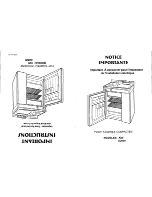
37
TROUBLESHOOTING GUIDE
TROUBLESHOOTING GUIDE
ICE & WATER
Problem
Possible Causes
Solutions
Icemaker is not
making enough ice
(continued).
Doors are opened often or for long
periods of time.
If the doors of the unit are opened often, ambient
air will warm the refrigerator which will prevent
the unit from maintaining the set temperature.
Lowering the refrigerator temperature can help,
as well as not opening the doors as frequently.
Doors are not closed completely.
If the doors are not properly closed, ice
production will be affected. See the Doors will
not close completely or pop open section in
Parts & Features Troubleshooting for more
information.
The temperature setting for the freezer
is too warm.
The recommended temperature for the freezer
compartment for normal ice production is
-18°C (0°F). If the freezer temperature is warmer,
ice production will be affected.
Dispensing water
slowly.
Water filter has been exhausted.
It is recommended that you replace the water
filter:
•Approximately every six months.
•When the water filter indicator turns on.
•When the water dispenser output decreases.
•When the ice cubes are smaller than normal.
Reverse osmosis filtration system is used. Reverse osmosis filtration systems can reduce
the water pressure below the minimum amount
and result in icemaker issues.
If the problem persists, it may be necessary to
contact a plumber.
Low house water supply pressure.
The water pressure must be between 138 and
828 kPa on models without a water filter and
between 276 and 828 kPa on models with a
water filter.
If the problem persists, it may be necessary to
contact a plumber.
Icemaker is not
making ice.
Refrigerator was recently installed or
icemaker recently connected.
It may take up to 24 hours for each compartment
to reach the desired temperature and for the
icemaker to begin making ice.
Icemaker not turned on.
Locate the icemaker ON/OFF switch and confirm
that it is in the ON (I) position.
The ice detecting sensor is obstructed.
Foreign substances or frost on the ice-detecting
sensor can interrupt ice production. Make sure
that the sensor area is clean at all times for
proper operation.
The refrigerator is not connected to a
water supply or the supply shutoff valve
is not turned on.
Connect refrigerator to the water supply and turn
the water shutoff valve fully open.
Icemaker shutoff (arm or sensor)
obstructed.
If your icemaker is equipped with an ice shutoff
arm, make sure that the arm moves freely. If your
icemaker is equipped with the electronic ice
shutoff sensor, make sure that there is a clear
path between the two sensors.
Reverse osmosis water filtration system
is connected to your cold water supply.
Reverse osmosis filtration systems can reduce
the water pressure below the minimum amount
and result in icemaker issues. (Refer to the Water
Pressure section.)
TROUBLESHOOTING GUIDE
Summary of Contents for GM-F208ST
Page 42: ......






































